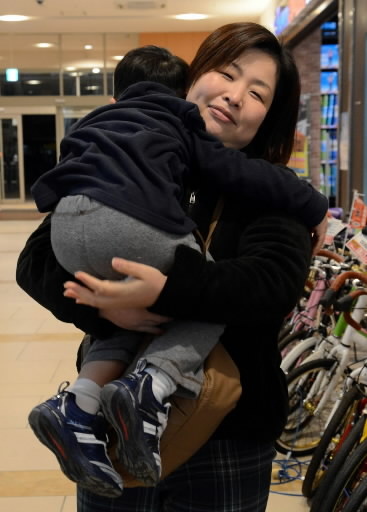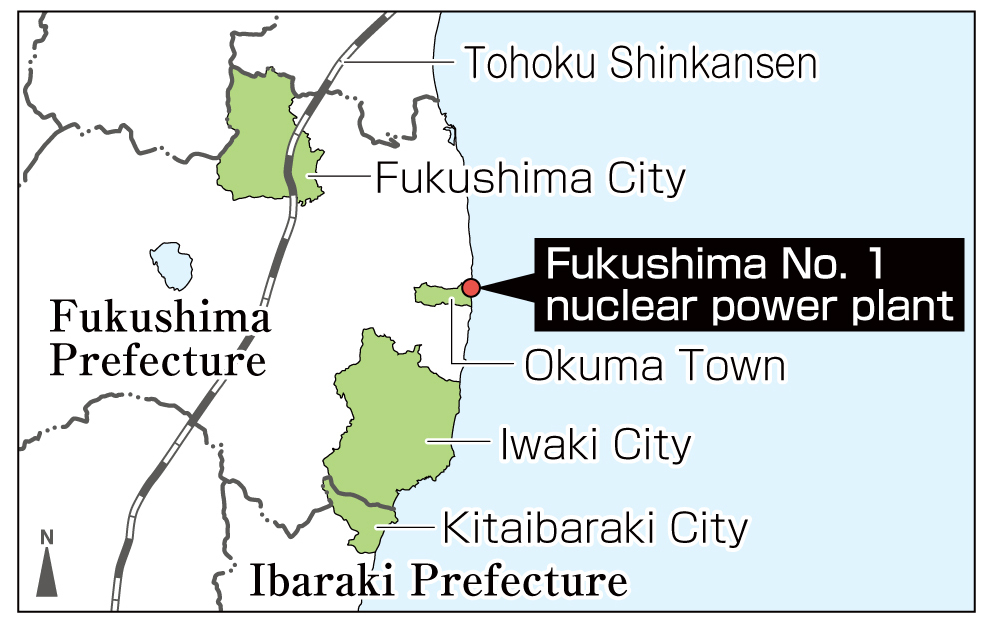Fukushima and Hiroshima: Two Years After the Great Eastern Japan Earthquake, Part 1
Mar. 13, 2013
Evacuees face dilemma over returning home
by Takamasa Kyoren, Staff Writer
Since the Great Eastern Japan Earthquake struck on March 11, 2011, the A-bombed city of Hiroshima has sought ways to assist those exposed to the nuclear accident in Fukushima. The sufferers have looked to Hiroshima with rising expectation, hoping that the city can provide support by making good use of the impressive body of knowledge on radiation damage and medical care for A-bomb survivors that has accumulated here over the years. The evacuees from Fukushima are now faced with the decision of whether or not to return to their hometowns, while support groups for these people have reached a point where their activities are worthy of review. To mark the second anniversary of the nuclear disaster, the Chugoku Shimbun will report on the current state of various connections involving Hiroshima and Fukushima.
Hiroshima or Fukushima?
“I wonder which city I’ll be living in in six months,” Sachiko Kanno, 40, wonders at her unit of the “employment promotion housing,” housing located in Nishi Ward, Hiroshima that has been designed for job seekers.
Ms. Kanno fled the city of Fukushima with her sons, ages 13, 11, and 5. Her hometown, about 60 kilometers northwest of the Fukushima No. 1 (Daiichi) nuclear power plant, was designated one of the areas most in need of decontamination work. Sharing her frank feelings, Ms. Kanno said, “No one knows how long the effects of this radioactivity will last. I’d like to stay in Hiroshima until my youngest son is grown.”
However, in March 2014, the central government will end support measures that have covered the full cost for “employment promotion housing.” Her husband, 50, is a teacher and he continues to live in Fukushima. These days, they meet just once every few months. Maintaining their separate lives now seems unfeasible.
If Ms. Kanno returns to Fukushima, she must make preparations for this move, including procedures to change her children’s schools. Her husband has asked that she make a decision by summer, and this deadline is now looming.
Even at municipal and prefectural dwellings in Hiroshima, free housing is provided to the evacuees for up to three years at most. In the wake of the nuclear disaster, about 320 people fled from Fukushima Prefecture to Hiroshima Prefecture. Now, two years later, many families are pressed to make decisions about the future.
“We have the same worries, and I want us to be able to share these concerns with one another,” Ms. Kanno said. As a contract worker of “Peacebuilders,” a non-profit organization based in downtown Hiroshima, Ms. Kanno is planning to hold lectures, at no charge, designed to support the evacuees who decide to return to their hometowns in eastern Japan. She has obtained financial support from Fukushima Prefecture and will invite an area researcher on radiation and a member of the prefecture’s board of education to take part.
“Alongside others, I’d like to learn about current conditions in our towns and ponder the future,” Ms. Kanno said. Four lectures have been held from January to March.
Misaki Tsuboi, 15, who lives in municipal housing in Minami Ward, Hiroshima, will graduate from Danbara Junior High School on March 12. She has chosen to go to high school in Iwaki City, Fukushima Prefecture, in the spring.
Misaki was born and raised in the town of Okuma, in Fukushima Prefecture, about 40 kilometers from Iwaki City. After the nuclear accident, she took refuge in Hiroshima with her parents and her older sister. At the end of March, Misaki and her family will move to the city of Kitaibaraki in the northern part of Ibaraki Prefecture, where her maternal grandparents live.
“I’ll feel more comfortable being near my hometown,” she said. “I’ll try my best not to think about the radiation.” Misaki will commute by train to high school, a 30-minute ride that crosses the prefectural boundary. Many of her friends, children she once played with until the nuclear accident occurred, will attend the same school.
Affection for their hometowns and concerns about radiation--the feelings of the evacuees continue to waver between the two.
(Originally published on March 4, 2013)
by Takamasa Kyoren, Staff Writer
Since the Great Eastern Japan Earthquake struck on March 11, 2011, the A-bombed city of Hiroshima has sought ways to assist those exposed to the nuclear accident in Fukushima. The sufferers have looked to Hiroshima with rising expectation, hoping that the city can provide support by making good use of the impressive body of knowledge on radiation damage and medical care for A-bomb survivors that has accumulated here over the years. The evacuees from Fukushima are now faced with the decision of whether or not to return to their hometowns, while support groups for these people have reached a point where their activities are worthy of review. To mark the second anniversary of the nuclear disaster, the Chugoku Shimbun will report on the current state of various connections involving Hiroshima and Fukushima.
Hiroshima or Fukushima?
“I wonder which city I’ll be living in in six months,” Sachiko Kanno, 40, wonders at her unit of the “employment promotion housing,” housing located in Nishi Ward, Hiroshima that has been designed for job seekers.
Ms. Kanno fled the city of Fukushima with her sons, ages 13, 11, and 5. Her hometown, about 60 kilometers northwest of the Fukushima No. 1 (Daiichi) nuclear power plant, was designated one of the areas most in need of decontamination work. Sharing her frank feelings, Ms. Kanno said, “No one knows how long the effects of this radioactivity will last. I’d like to stay in Hiroshima until my youngest son is grown.”
However, in March 2014, the central government will end support measures that have covered the full cost for “employment promotion housing.” Her husband, 50, is a teacher and he continues to live in Fukushima. These days, they meet just once every few months. Maintaining their separate lives now seems unfeasible.
If Ms. Kanno returns to Fukushima, she must make preparations for this move, including procedures to change her children’s schools. Her husband has asked that she make a decision by summer, and this deadline is now looming.
Even at municipal and prefectural dwellings in Hiroshima, free housing is provided to the evacuees for up to three years at most. In the wake of the nuclear disaster, about 320 people fled from Fukushima Prefecture to Hiroshima Prefecture. Now, two years later, many families are pressed to make decisions about the future.
“We have the same worries, and I want us to be able to share these concerns with one another,” Ms. Kanno said. As a contract worker of “Peacebuilders,” a non-profit organization based in downtown Hiroshima, Ms. Kanno is planning to hold lectures, at no charge, designed to support the evacuees who decide to return to their hometowns in eastern Japan. She has obtained financial support from Fukushima Prefecture and will invite an area researcher on radiation and a member of the prefecture’s board of education to take part.
“Alongside others, I’d like to learn about current conditions in our towns and ponder the future,” Ms. Kanno said. Four lectures have been held from January to March.
Misaki Tsuboi, 15, who lives in municipal housing in Minami Ward, Hiroshima, will graduate from Danbara Junior High School on March 12. She has chosen to go to high school in Iwaki City, Fukushima Prefecture, in the spring.
Misaki was born and raised in the town of Okuma, in Fukushima Prefecture, about 40 kilometers from Iwaki City. After the nuclear accident, she took refuge in Hiroshima with her parents and her older sister. At the end of March, Misaki and her family will move to the city of Kitaibaraki in the northern part of Ibaraki Prefecture, where her maternal grandparents live.
“I’ll feel more comfortable being near my hometown,” she said. “I’ll try my best not to think about the radiation.” Misaki will commute by train to high school, a 30-minute ride that crosses the prefectural boundary. Many of her friends, children she once played with until the nuclear accident occurred, will attend the same school.
Affection for their hometowns and concerns about radiation--the feelings of the evacuees continue to waver between the two.
(Originally published on March 4, 2013)









